基础语法 九种成分 课件-2025届初三英语一轮复习(共24张PPT)
文档属性
| 名称 | 基础语法 九种成分 课件-2025届初三英语一轮复习(共24张PPT) | 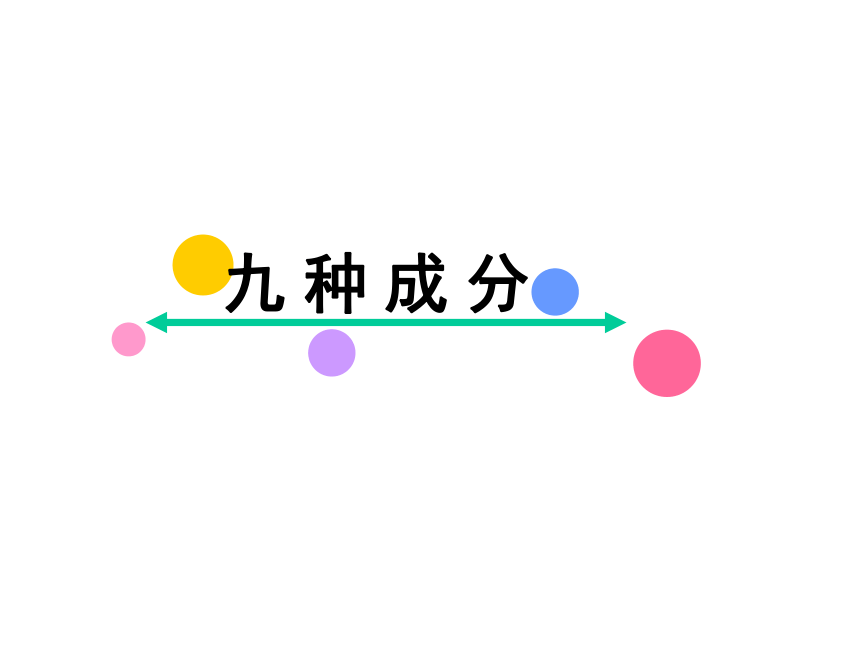 | |
| 格式 | pptx | ||
| 文件大小 | 284.6KB | ||
| 资源类型 | 教案 | ||
| 版本资源 | 人教新目标(Go for it)版 | ||
| 科目 | 英语 | ||
| 更新时间 | 2024-07-16 17:19:31 | ||
图片预览

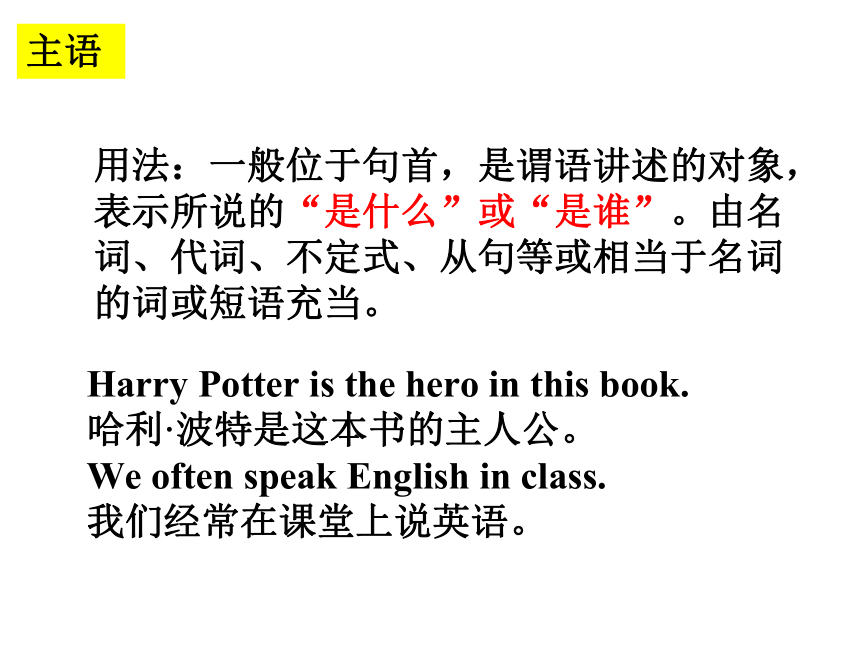
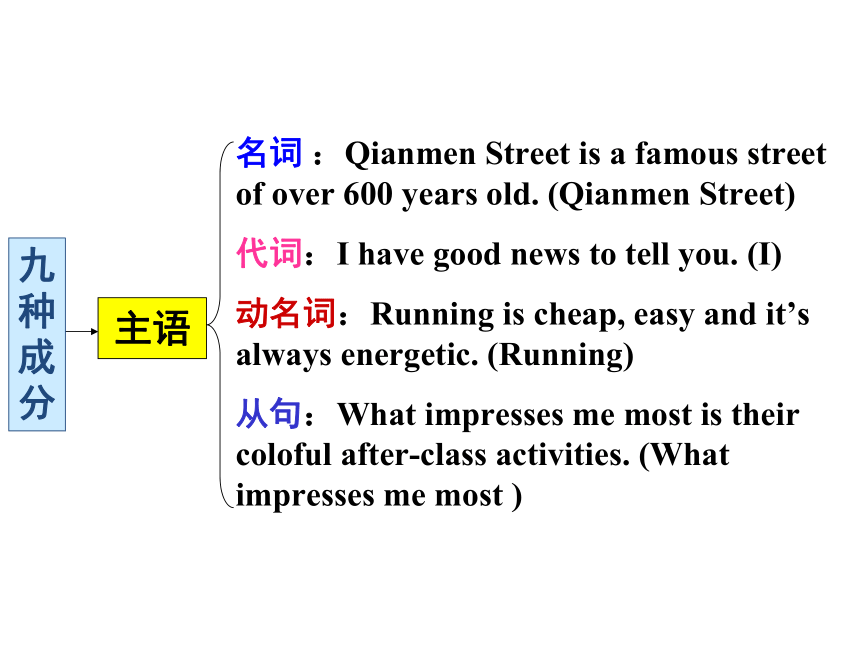
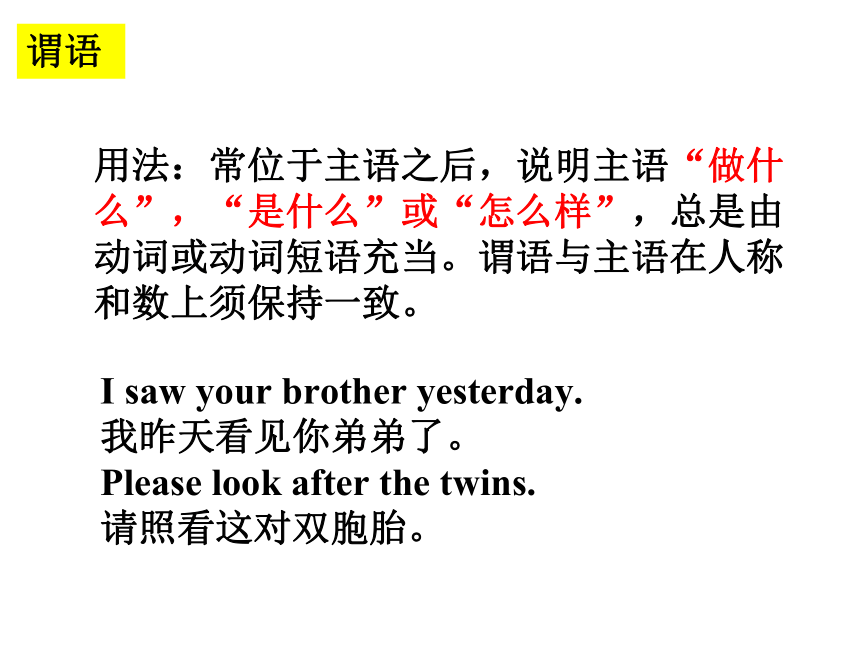
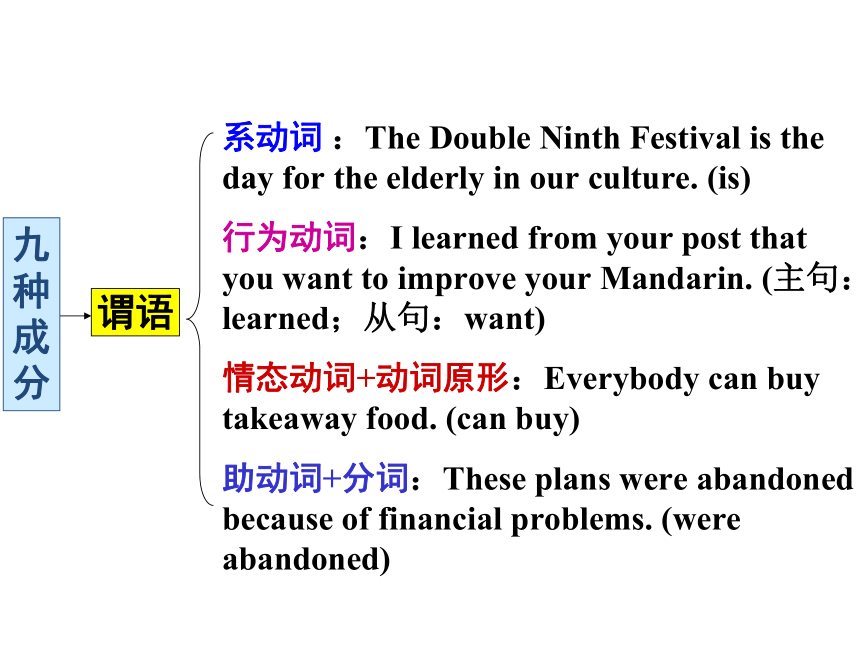
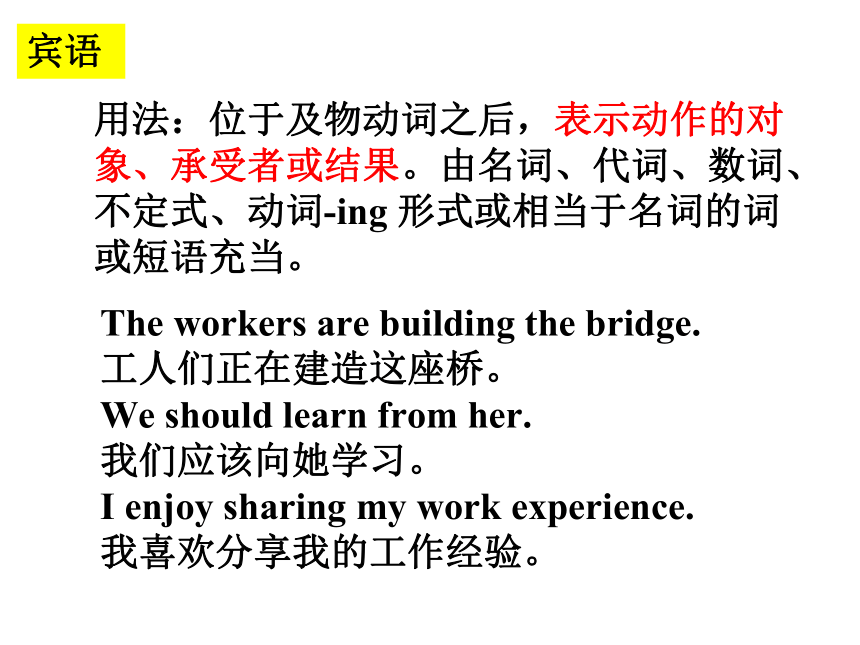
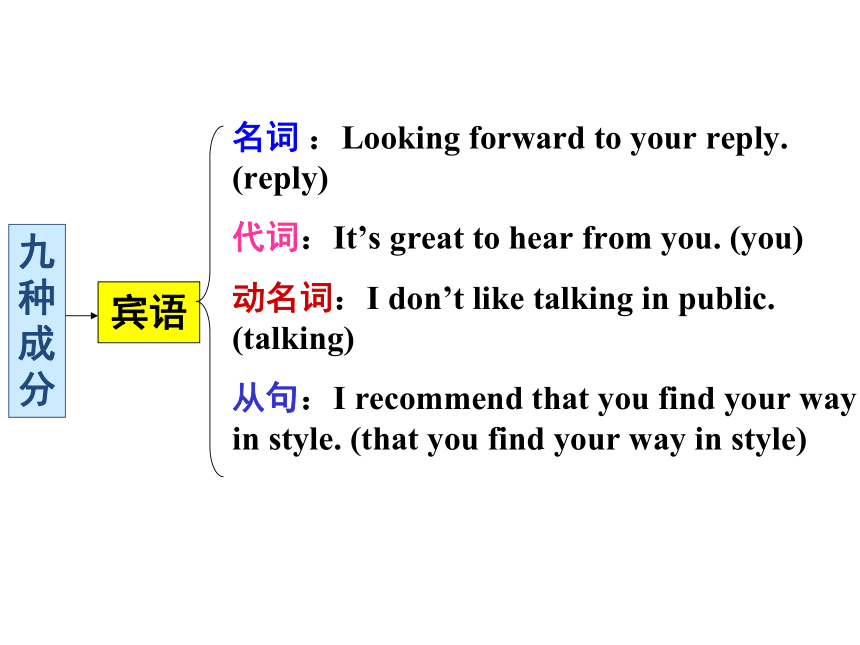
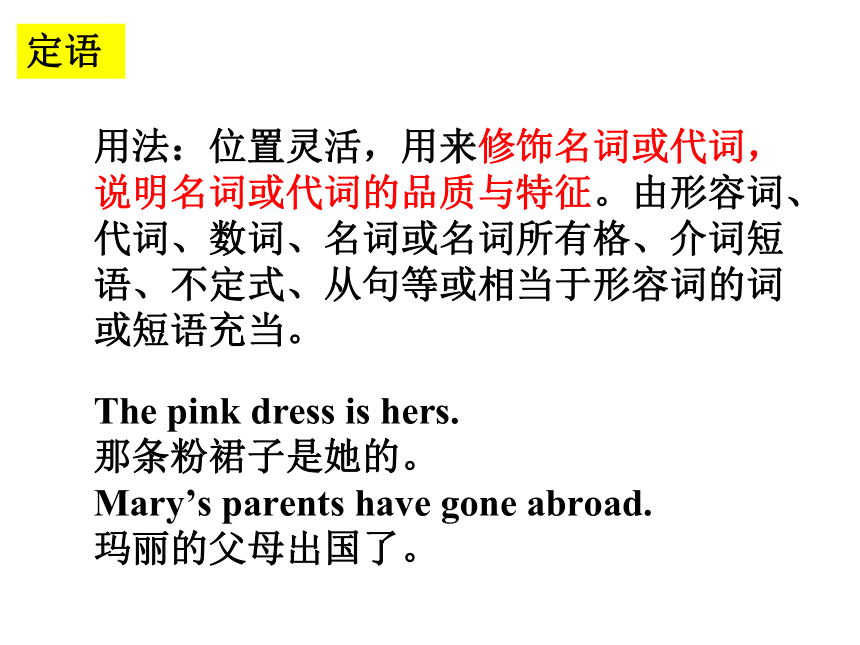

文档简介
(共24张PPT)
九 种 成 分
用法:一般位于句首,是谓语讲述的对象,表示所说的“是什么”或“是谁”。由名词、代词、不定式、从句等或相当于名词的词或短语充当。
主语
Harry Potter is the hero in this book.
哈利·波特是这本书的主人公。
We often speak English in class.
我们经常在课堂上说英语。
主语
名词 :Qianmen Street is a famous street of over 600 years old. (Qianmen Street)
代词:I have good news to tell you. (I)
动名词:Running is cheap, easy and it’s always energetic. (Running)
从句:What impresses me most is their coloful after-class activities. (What impresses me most )
九
种
成
分
用法:常位于主语之后,说明主语“做什么”,“是什么”或“怎么样”,总是由动词或动词短语充当。谓语与主语在人称和数上须保持一致。
谓语
I saw your brother yesterday.
我昨天看见你弟弟了。
Please look after the twins.
请照看这对双胞胎。
谓语
系动词 :The Double Ninth Festival is the day for the elderly in our culture. (is)
行为动词:I learned from your post that you want to improve your Mandarin. (主句:learned;从句:want)
情态动词+动词原形:Everybody can buy takeaway food. (can buy)
助动词+分词:These plans were abandoned because of financial problems. (were abandoned)
九
种
成
分
用法:位于及物动词之后,表示动作的对象、承受者或结果。由名词、代词、数词、不定式、动词-ing 形式或相当于名词的词或短语充当。
宾语
The workers are building the bridge.工人们正在建造这座桥。
We should learn from her.
我们应该向她学习。
I enjoy sharing my work experience.我喜欢分享我的工作经验。
宾语
名词 :Looking forward to your reply. (reply)
代词:It’s great to hear from you. (you)
动名词:I don’t like talking in public. (talking)
从句:I recommend that you find your way in style. (that you find your way in style)
九
种
成
分
用法:位置灵活,用来修饰名词或代词,说明名词或代词的品质与特征。由形容词、代词、数词、名词或名词所有格、介词短语、不定式、从句等或相当于形容词的词或短语充当。
定语
The pink dress is hers.
那条粉裙子是她的。
Mary’s parents have gone abroad.
玛丽的父母出国了。
定语
I'm writing to tell you my exciting plan for the summer holiday. (exciting)
I have something interesting to tell you. (interesting, 修饰不定代词后置)
九
种
成
分
用法:可位于句首、句末或句中。用来修饰动词、形容词、副词或整个句子,表示行为发生的时间、地点、目的、原因、方式、程度等。由副词、介词短语、不定式或相当于副词的词或短语充当。
状语
Unfortunately, I missed the train.
很不幸,我错过了火车。
Factories and building are seen here and there.
到处都能见到工厂和建筑物。
状语
修饰动词 :He can speak English fluently. (fluently)
修饰形容词:The suitcase is surprisingly light. (surprisingly)
修饰另一副词:I go jogging fairly regularly. (fairly)
修饰全句:Surprisingly, he agreed straight away. (Surprisingly)
状语从句:If you’d like to bring a gift, fruit is usually a good choice. (If you’d like to...)
九
种
成
分
用法:位于系动词之后,说明主语“是什么”,“怎么样”。由名词、代词、数词、形容词、副词、介词短语、不定式、从句等充当。
表语
Andy and I are friends.
我和安迪是好朋友。
I’m fourteen.我 14 岁了。
Leaves have gone yellow.树叶变黄了。
上述例句中的动词“是”、“有”、“听起来”都不能由主语实际发出,这些动作都表示主语与宾语或补语的联系,我们称这种表达主语与宾语或补语联系的动词叫系动词。
系动词
I am a student.我是学生。
I have a watch.我有一块表。
The song sounds great.歌听起来不错。
在英语里,常见系动词包括表示“是”概念的be动词,看起来(look)、听起来(sound)、闻起来(smell)等感官动词、有(have)等。
The match became very exciting. (exciting)
They look really beautiful in the shape of
a diamond. (beautiful)
表语
九
种
成
分
用法:位于宾语后,用来补充宾语的意义。由名词、形容词、副词、介词短语,不定式、动词-ing 形式、过去分词等充当。
宾语补足语
Please call me Tom.请叫我汤姆。
Let the fresh air in.让新鲜空气进来。
His blame made Mary cry.
他的责备让玛丽哭了
补语
宾补:We’ll make our school more beautiful. (more beautiful)
主补:The professor was seen making an experiment in the chemistry lab. (making...)
九
种
成
分
用法:当两个指同一人或事物的句子成分放在同等位置时,若其中一个句子成分是用于说明或解释另一个句子成分的,那么用于起说明或解释作用的句子成分就叫做另一成分的同位语。
同位语
The biggest city in China, Hulun Buir is a city of low population density. 中国最大的城市,呼伦贝尔,是一个低密度人口城市。
同位语
名词 :My favourite figure must be Wei Yuan, a great thinker in the late Qing Dynasty. (a great thinker)
代词:Helping others is a habit, one you can learn. (one)
从句:We are glad at the news that he will come. (that he will come)
九
种
成
分
用法:插入语指的是插在句子中的一个词、短语或句子,其作用是用来补充含义,或解释说明。插入语独立性强,一般用标点符号将其与其他句子成分隔开。在句中与其他部分没有语法上的联系,将它删掉之后,句子结构仍然完整。
插入语
Other standardized tests, such as the Scholastic Assessment Test(SAT) and the Graduate Record Exam(GRE), capture the main aspects of IQ tests.
插入语
短句 :That, I think, would be a great advantage. (I think)
不定式:To tell you the truth, I hate to
do it. (To tell you the truth)
分词:Generally speaking, we enjoyed
the trip. (Generally speaking)
介词短语:In short, we should stop
halfway. (In short)
形容词:Worse still, we got lost in the
dark. (Worse still)
副词:I can’t go. To begin with, it’s too
cold. Besides, I’ve no money. (Besides)
九
种
成
分
同位语和插入语很像,都是后插进来的补充成分,他们的区别在于同位语与前面的名词有关系,说的是同一个人或同一件事。而插入语则没有直接关系。
Tony, my teacher, is coming here.
Tony, with his students, is coming here.
【补充】
解析:my teacher是同位语,解释说明Tony是谁,Tony和my teacher说的是同一个人。
解析:with his students是插入语,补充说明Tony和谁一起来。Tony和with his students不是同一个人。
请指出下列各句的句子成分,定语用
括号括起来。
1. We learned them at a young age.
We (主语) learned (谓语) them (宾语) at a young age (状语).
2. I will help you read and understand the selected poems.
I (主语) will help (谓语) you (宾语) read and understand the selected poems (宾补).
3. The museum is on the Yellow River Road.
The museum (主语) is (系动词) on the Yellow River Road (表语).
4. We can meet at the bus stop outside the school gate at 9 a.m.
We (主语) can meet (谓语) at the bus stop outside the school gate (地点状语) at 9 a.m (时 间状语).
九 种 成 分
用法:一般位于句首,是谓语讲述的对象,表示所说的“是什么”或“是谁”。由名词、代词、不定式、从句等或相当于名词的词或短语充当。
主语
Harry Potter is the hero in this book.
哈利·波特是这本书的主人公。
We often speak English in class.
我们经常在课堂上说英语。
主语
名词 :Qianmen Street is a famous street of over 600 years old. (Qianmen Street)
代词:I have good news to tell you. (I)
动名词:Running is cheap, easy and it’s always energetic. (Running)
从句:What impresses me most is their coloful after-class activities. (What impresses me most )
九
种
成
分
用法:常位于主语之后,说明主语“做什么”,“是什么”或“怎么样”,总是由动词或动词短语充当。谓语与主语在人称和数上须保持一致。
谓语
I saw your brother yesterday.
我昨天看见你弟弟了。
Please look after the twins.
请照看这对双胞胎。
谓语
系动词 :The Double Ninth Festival is the day for the elderly in our culture. (is)
行为动词:I learned from your post that you want to improve your Mandarin. (主句:learned;从句:want)
情态动词+动词原形:Everybody can buy takeaway food. (can buy)
助动词+分词:These plans were abandoned because of financial problems. (were abandoned)
九
种
成
分
用法:位于及物动词之后,表示动作的对象、承受者或结果。由名词、代词、数词、不定式、动词-ing 形式或相当于名词的词或短语充当。
宾语
The workers are building the bridge.工人们正在建造这座桥。
We should learn from her.
我们应该向她学习。
I enjoy sharing my work experience.我喜欢分享我的工作经验。
宾语
名词 :Looking forward to your reply. (reply)
代词:It’s great to hear from you. (you)
动名词:I don’t like talking in public. (talking)
从句:I recommend that you find your way in style. (that you find your way in style)
九
种
成
分
用法:位置灵活,用来修饰名词或代词,说明名词或代词的品质与特征。由形容词、代词、数词、名词或名词所有格、介词短语、不定式、从句等或相当于形容词的词或短语充当。
定语
The pink dress is hers.
那条粉裙子是她的。
Mary’s parents have gone abroad.
玛丽的父母出国了。
定语
I'm writing to tell you my exciting plan for the summer holiday. (exciting)
I have something interesting to tell you. (interesting, 修饰不定代词后置)
九
种
成
分
用法:可位于句首、句末或句中。用来修饰动词、形容词、副词或整个句子,表示行为发生的时间、地点、目的、原因、方式、程度等。由副词、介词短语、不定式或相当于副词的词或短语充当。
状语
Unfortunately, I missed the train.
很不幸,我错过了火车。
Factories and building are seen here and there.
到处都能见到工厂和建筑物。
状语
修饰动词 :He can speak English fluently. (fluently)
修饰形容词:The suitcase is surprisingly light. (surprisingly)
修饰另一副词:I go jogging fairly regularly. (fairly)
修饰全句:Surprisingly, he agreed straight away. (Surprisingly)
状语从句:If you’d like to bring a gift, fruit is usually a good choice. (If you’d like to...)
九
种
成
分
用法:位于系动词之后,说明主语“是什么”,“怎么样”。由名词、代词、数词、形容词、副词、介词短语、不定式、从句等充当。
表语
Andy and I are friends.
我和安迪是好朋友。
I’m fourteen.我 14 岁了。
Leaves have gone yellow.树叶变黄了。
上述例句中的动词“是”、“有”、“听起来”都不能由主语实际发出,这些动作都表示主语与宾语或补语的联系,我们称这种表达主语与宾语或补语联系的动词叫系动词。
系动词
I am a student.我是学生。
I have a watch.我有一块表。
The song sounds great.歌听起来不错。
在英语里,常见系动词包括表示“是”概念的be动词,看起来(look)、听起来(sound)、闻起来(smell)等感官动词、有(have)等。
The match became very exciting. (exciting)
They look really beautiful in the shape of
a diamond. (beautiful)
表语
九
种
成
分
用法:位于宾语后,用来补充宾语的意义。由名词、形容词、副词、介词短语,不定式、动词-ing 形式、过去分词等充当。
宾语补足语
Please call me Tom.请叫我汤姆。
Let the fresh air in.让新鲜空气进来。
His blame made Mary cry.
他的责备让玛丽哭了
补语
宾补:We’ll make our school more beautiful. (more beautiful)
主补:The professor was seen making an experiment in the chemistry lab. (making...)
九
种
成
分
用法:当两个指同一人或事物的句子成分放在同等位置时,若其中一个句子成分是用于说明或解释另一个句子成分的,那么用于起说明或解释作用的句子成分就叫做另一成分的同位语。
同位语
The biggest city in China, Hulun Buir is a city of low population density. 中国最大的城市,呼伦贝尔,是一个低密度人口城市。
同位语
名词 :My favourite figure must be Wei Yuan, a great thinker in the late Qing Dynasty. (a great thinker)
代词:Helping others is a habit, one you can learn. (one)
从句:We are glad at the news that he will come. (that he will come)
九
种
成
分
用法:插入语指的是插在句子中的一个词、短语或句子,其作用是用来补充含义,或解释说明。插入语独立性强,一般用标点符号将其与其他句子成分隔开。在句中与其他部分没有语法上的联系,将它删掉之后,句子结构仍然完整。
插入语
Other standardized tests, such as the Scholastic Assessment Test(SAT) and the Graduate Record Exam(GRE), capture the main aspects of IQ tests.
插入语
短句 :That, I think, would be a great advantage. (I think)
不定式:To tell you the truth, I hate to
do it. (To tell you the truth)
分词:Generally speaking, we enjoyed
the trip. (Generally speaking)
介词短语:In short, we should stop
halfway. (In short)
形容词:Worse still, we got lost in the
dark. (Worse still)
副词:I can’t go. To begin with, it’s too
cold. Besides, I’ve no money. (Besides)
九
种
成
分
同位语和插入语很像,都是后插进来的补充成分,他们的区别在于同位语与前面的名词有关系,说的是同一个人或同一件事。而插入语则没有直接关系。
Tony, my teacher, is coming here.
Tony, with his students, is coming here.
【补充】
解析:my teacher是同位语,解释说明Tony是谁,Tony和my teacher说的是同一个人。
解析:with his students是插入语,补充说明Tony和谁一起来。Tony和with his students不是同一个人。
请指出下列各句的句子成分,定语用
括号括起来。
1. We learned them at a young age.
We (主语) learned (谓语) them (宾语) at a young age (状语).
2. I will help you read and understand the selected poems.
I (主语) will help (谓语) you (宾语) read and understand the selected poems (宾补).
3. The museum is on the Yellow River Road.
The museum (主语) is (系动词) on the Yellow River Road (表语).
4. We can meet at the bus stop outside the school gate at 9 a.m.
We (主语) can meet (谓语) at the bus stop outside the school gate (地点状语) at 9 a.m (时 间状语).
